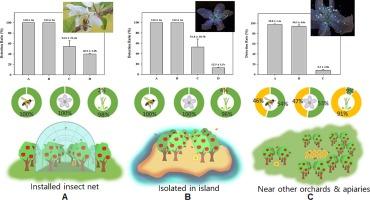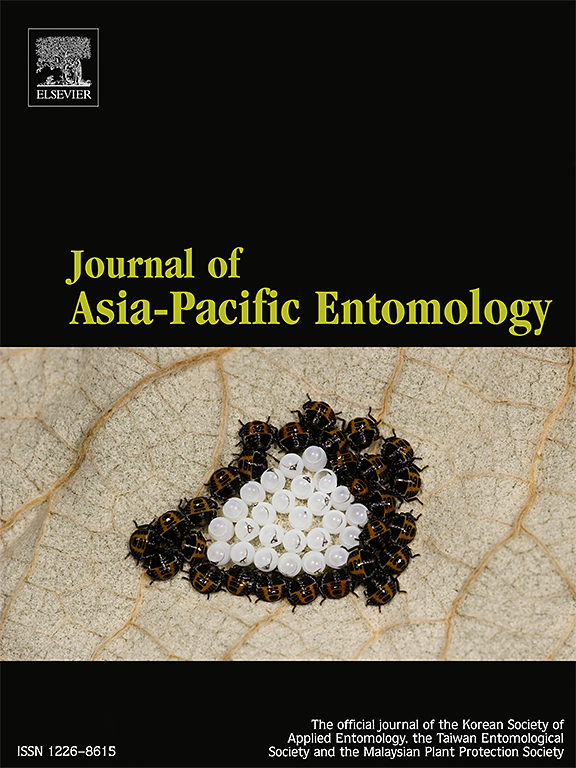蜜蜂(Apis mellifera L.)在苹果园中传播磷光微生物制剂
IF 1.1
3区 农林科学
Q3 ENTOMOLOGY
引用次数: 0
摘要
蜜蜂通常用于苹果园的授粉。本研究旨在开发一种蜜蜂媒介计划,蜜蜂(Apis mellifera L.)可通过蜂箱入口处的分配器向苹果花输送抗枯萎病的微生物制剂(淀粉芽孢杆菌 MBI600)。比较了蜜蜂在四个苹果园中传播磷光微生物制剂(PMA)的效率:(A) 安装了防虫网,(B) 孤立在一个小岛上,(C) 毗邻其他苹果园和养蜂场,(D) C 附近 50 米内无蜂箱。果园(A)和(B)中蜜蜂探花的 PMA 平均检测率为 100%,而(C)和(D)分别为 54.5% 和 40.0%。苹果花上的 PMA 检测率在(A)和(B)中也是 100%,但在(C)和(D)中明显较低,分别为 52.8 % 和 12.9 %。在果园(A)和(B)中,PMA 附着在雌蕊上的比例较高,分别为 98.0 % 和 96.3 %,而在果园(C)中,PMA 附着在雌蕊上的比例明显较低,仅为 9.3 %。此外,还研究了花朵中的磷光强度和蜜蜂采集到的苹果花粉量的比例。最后,与果园(A)和(B)相比,开放果园(C)和(D)通过蜜蜂载体传播微生物菌剂的效率明显较低。对于开放式果园,加强蜜蜂载体传播的补充策略可包括增加果园中的蜂箱数量,在开花期间临时迁移邻居的蜂箱,或向附近的养蜂场提供额外的分配器。本文章由计算机程序翻译,如有差异,请以英文原文为准。

Dissemination of phosphorescent microbial agents by honey bees (Apis mellifera L.) in apple orchards
Honey bees are commonly used for pollination in apple orchards. This study aimed to develop a bee-vectoring scheme whereby honey bees (Apis mellifera L.) deliver microbial agents (Bacillus amyloliquefaciens MBI600) against fire blight from a dispenser at the entrance of the beehive to apple flowers. The efficiency of disseminating phosphorescent microbial agents (PMA) by honey bees was compared across four apple orchards; (A) with installed insect nets, (B) isolated on an island, (C) adjacent to other apple orchards and apiaries, and (D) near C within 50 m and without beehives. The average detection ratio of PMA on bees visiting flowers was 100 % in orchard (A) and (B), whereas in (C) and (D) it was 54.5 % and 40.0 %, respectively. Detection of PMA on apple blossoms was also 100 % in (A) and (B), but significantly low in (C) and (D) at 52.8 % and 12.9 %. In orchards (A) and (B), PMA adhered to pistils at high ratios of 98.0 % and 96.3 %, while in orchard (C), it was significantly lower at 9.3 %. Phosphorescence intensity in flowers and the proportion of apple pollen loads collected from incoming bees were also investigated. Finally compared to the orchard (A) and (B), open orchard (C) and (D) showed significantly lower microbial agent spread efficiency by honey bee vectoring. For open orchards, supplemental strategy to enhance bee vectoring could include increasing the number of hives in the orchard and temporarily relocating neighbor’s beehives during flowering, or supplying additional dispensers to nearby apiaries.
求助全文
通过发布文献求助,成功后即可免费获取论文全文。
去求助
来源期刊

Journal of Asia-pacific Entomology
Agricultural and Biological Sciences-Insect Science
CiteScore
2.70
自引率
6.70%
发文量
152
审稿时长
69 days
期刊介绍:
The journal publishes original research papers, review articles and short communications in the basic and applied area concerning insects, mites or other arthropods and nematodes of economic importance in agriculture, forestry, industry, human and animal health, and natural resource and environment management, and is the official journal of the Korean Society of Applied Entomology and the Taiwan Entomological Society.
 求助内容:
求助内容: 应助结果提醒方式:
应助结果提醒方式:


